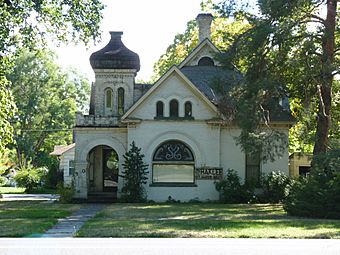Knight–Allen House facts for kids
Quick facts for kids |
|
|
Knight–Allen House
|
|

Knight–Allen House
|
|
| Location | 390 East Center Street Provo, Utah |
|---|---|
| Area | 0.25 acre |
| Built | 1899 |
| Architect | Richard C. Watkins |
| Architectural style | Classical Revival, Romanesque, Victorian Eclecticism, Other |
| MPS | Entreprenurial Residences of Turn-of-the-Century Provo TR |
| NRHP reference No. | 82004175 |
| Added to NRHP | July 23, 1982 |
The Knight–Allen House is a really old and important house in Provo, Utah. It's so special that it's listed on the National Register of Historic Places. This means it's officially recognized for its history and unique design.
Contents
What Makes the Knight–Allen House Special?
This amazing house was built way back in 1888. It's a great example of 'Victorian Eclectic' style. This means it mixes many cool designs from the Victorian era. Look for its unique roof, a round tower, and fancy windows. It was even named a special historic landmark by Provo City in 1996.
Who Was Jesse Knight?
Jesse Knight was a very rich and important man in Provo. He was born in 1845 in Nauvoo, Illinois. His family moved west and arrived in Utah in 1857. Later, Jesse married Amanda McEwan and started a ranch near Payson.
Jesse had an idea to start mining in the Eureka area. This made him very wealthy! He bought more mines and even started a bank. He also owned land in Provo, a wool factory, and farms in Canada. Jesse was a strong supporter of The Church of Jesus Christ of Latter-day Saints. His mines were known for being very clean and well-run.
Jesse Knight passed away in 1921. He left a lot of his money to Brigham Young University and other good causes. After he died, his daughter, Inez Knight Allen, and her husband lived in the Knight–Allen House.
Provo's Grand Victorian Mansions
Between 1893 and 1908, many grand Victorian mansions were built in Provo. These homes are important because they show off amazing architecture. They also belonged to some of the most successful people in the city and state.
The Knight–Allen House is one of these special homes. Other mansions include the Charles E. Loose House, the William H. Ray House, the John R. Twelves House, the Jesse Knight House, the Knight–Mangum House, and the Thomas N. Taylor House. These houses feature different styles like Eastlake, Shingle, and Classical Revival. Most are made of brick and have beautiful, detailed designs.
Jesse Knight's Mining Empire
Mining for valuable metals like silver and gold changed Utah's economy. It helped Utah grow from mostly farms to more industries. The Tintic Mining District, southwest of Provo, was a big part of this. It started in 1869 and became Utah's top mining center by 1899.
Jesse Knight was a key person in the success of Tintic mining. His family lived in Provo. Jesse's business grew beyond just the Tintic mines. He owned a power plant, a large farm, and even smelters. His company, the Knight Investment Company, had many different businesses. These included mining, ranching, sugar companies, and banks. Because of all this success, the Knight–Allen House was built. It was likely designed by a Provo architect named Richard C. Watkins.
Protecting the Knight–Allen House
The Knight–Allen House was added to the National Register of Historic Places in 1982. It was part of a group of six important Provo houses listed at that time. These houses include the Knight–Mangum House, the John R. Twelves House, the Jesse Knight House, the Knight–Allen House, the William H. Ray House, and the Thomas N. Taylor House.
Images for kids




